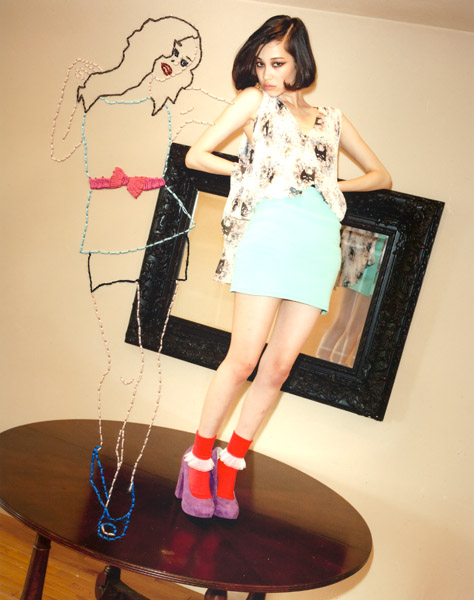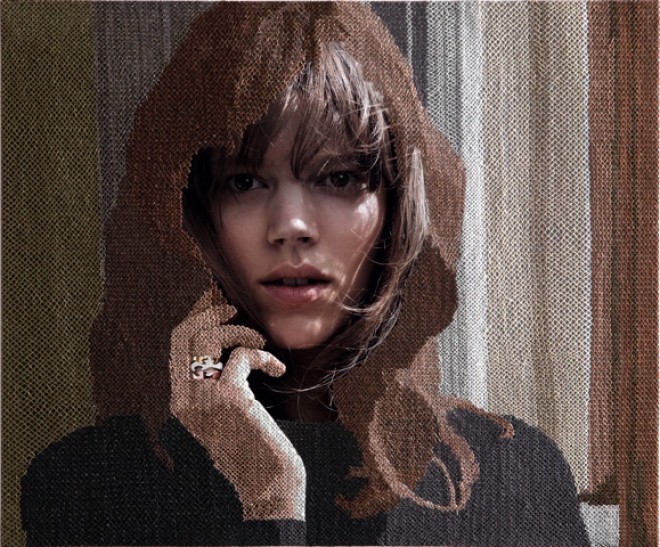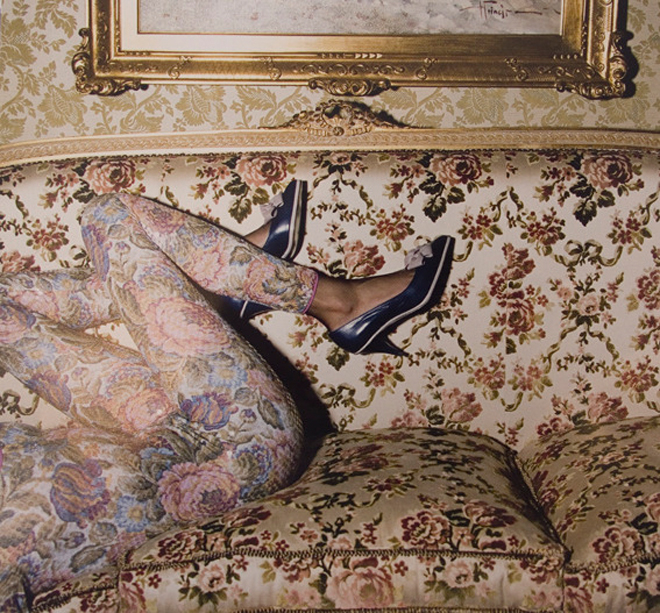Inge Jacobsen uses embroidery, cutting, and collaging to create new images out of magazine fashion editorial and newspaper imagery.
As well as a response to the mass of imagery that makes up the modern world, her work comments on the way the female body is used as a commercial object. Intricate, time consuming and unique, her craft ruptures the gloss and glamour of the fashion world to create something lasting.
The 25-year-old’s work will be on show at the SHOWstudio shop as part of their Selling Sex exhibition from Thursday.
Twin spoke to the artist about her work…
What came first for you, art or craft?
Art. I was very interested in drawing and painting before I started university and I still do it from time to time. I spent much of my childhood and teenage years painting, and I originally wanted to be a painter.
When and why did you first apply embroidery to images of women?
When I started studying Fine Art at Kingston University in 2006. We were encouraged to think outside the box and explore ideas rather than specific techniques, so there was a lot of freedom to do as you pleased with your work. It was difficult at the beginning because I was surrounded by all of these incredibly talented and creative people, so I found it hard to create anything original.
I stated collecting fashion magazines knowing that I wanted to work with that sort of imagery, I just needed a way to intervene into them. I had found some embroidery pieces from my school days in Denmark when I was moving to university and thought that that would be a great method to use.
Your work has been embraced by the fashion industry – how important is it to you to keep your point of view undiluted by commercial projects?
Well I’m incredibly stubborn, so I find it quite easy. I don’t mind doing commercial projects if I think they will complement my ideas, such as the one I did with the Georg Jensen campaign. That worked for me because they have a long traditional craft based history (silversmiths) and a lot of their pieces are still made by hand in Denmark. I felt this was important because my work is handmade by me and it is a very traditional craft embroidery. I am happy to do commercial projects as long I don’t feel like I’m compromising the bases of my work and ideas.

What challenges does having feminist sensibilities, but also enjoying fashion, pose for you?
I think the two can work very well together. It can be difficult at times to distinguish whether women are being empowered or exploited but it certainly isn’t a not a black and white issue. I love the clothes but I often have an issue with the size of the models. They seem to be getting younger and skinnier and its not a great look in my opinion.
Clothes and fashion can help some women, and men, feel empowered but magazines and other imagery from that industry can also be great at making you feel awful about yourself. It does set unrealistic standards on ‘real’ women which I do find frustrating. The same is true for some types of porn, particularly those made by large industries. I was sad to learn that the only three industries where women earn more than men is in pornography, prostitution and modelling. We need to do better than this as a society.
What fashion designers do you admire as artists?
Christopher Bailey because he has done such a brilliant job at Burberry and Miuccia Prada because Miu Miu and Prada always make me smile with their bright colours and quirky designs.

Can you tell me a bit about your participation in the Selling Sex exhibition for ShowStudio?
The exhibition is made up of female artists and is really a look at how male gendered our visual culture is. The gallery contacted me and asked if I would like to include some of my stitched porn illustration in the show and any other work that I felt would contribute to the theme of the exhibition.
I was so flattered to be included and have my work next to such great artists. The subject is also one that is very important to me as a woman and as an artist. It is refreshing for stitching and embroidery to be displayed as equals to painting and sculpture because, like many crafts, it is so often mistaken for a lower form of art and people need to understand that that is not the case.
How long does one of your ‘covers’ take on average to complete?
You know, I get asked this a lot, and I can see why people are interested considering how intricate some of the pieces are, but honestly, I don’t keep track of the time. It all depends on how detailed an image is and how big it is. Sometimes I’ll start working on a piece and then leave it for days without touching it, so it’s hard to keep track of time. I have said 30- 50 hours in the past but I think it’s more around the 20 hour mark now that I’ve become quicker at it.
What’s next for you?
I am currently working with photographer Rebecca Thomas and using a series of her images. I’m also experimenting with different type of stitch to create a paint like effect, with stitches that resemble brush strokes.
Selling Sex opens on March 22 and runs until June 1 at SHOWstudio Shop, 1-9 Bruton Place, London









 Twitter
Twitter
 Tumblr
Tumblr
 YouTube
YouTube
 Facebook
Facebook
 Instagram
Instagram
